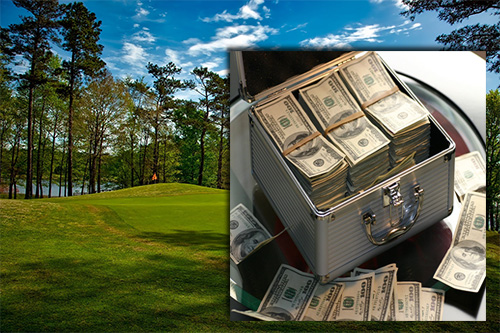
November 23, 2020 | BY AAGD STAFF
Come on now, don’t tell me that you still judge a book by its cover? We all know by now, that everything that glitters is not gold. The same is true for the “so-called” lavish lifestyle of a touring golf professional. Think about it, sitting in your favorite spot at home and watching a tournament on TV, you have probably thought, “Wow, what a wonderful life. Getting paid to do something you absolutely love!”
Yes, no doubt, golf pros love what they do, yet– like any highly-visible position–this occupation has its benefits: picturesque destinations, throngs of fans clamoring for attention, exciting cities to explore after the competition, and a big wad of money on the line–depending on your performance. “Yes, this is the life,” some may think. However, many touring pros have been heard to say that this is only one side of their ‘livid lives.’ Their role is stressful, injurious, and keeps many away throughout the year from the company of their loving families.
Consider these 5 myths about tour pros.
1. All tour pros are rolling in the dough (millionaires)
Although is true that the top-tier players, i.e. Tiger Woods, Rickie Fowler, and Justin Thomas are multi-millionaires who enjoy an extremely comfortable living, not all tour pros are reaping these momentous sums of money. According to PGA Tour statistics, of the 254 players that earned prize money on the PGA Tour during the 2019–2020 season, less than half of those players (91) reeled in more than $1 million dollars.
Even on the Korn Ferry Tour, prize money for the season ranged from $550,000 down to $1,200. There is big money to be made, but most tour players are in the grind and struggle to earn a living, hoping that one day they will ‘strike’ it rich and earn a big jackpot.
2. Putts 10 feet or shorter are always made by tour pros
Make a 10 feet or shorter putt is a given, right? Un, huh. The truth is that the top ranked player last season in putts made from five to nine feet was Bryson DeChambeau. This 7-time, PGA Tour winner holed out just 67 percent of his putts from that distance. And, from 10–15 feet (40 percent) that number drops significantly. The lesson here: don’t scold yourself for missing short putts. The best players in the world miss them, too.
3. Luxury is the name of the game
This is a big misconception that people have of pro golfers. Only if your name is Tiger Woods, Brooks Koepka, or Dustin Johnson, the life of NetJets, private homes, and personal chefs is a part of your daily regular lifestyle. But, not so for most pros. Their grind has to be handled by themselves, with many players ‘carpooling’ and sharing hotel rooms, eating at fast-food stops while chasing their dreams at a much lower scale of the so-called luxury lifestyle.
It’s been said that making $100k on the Korn Ferry Tour actually leaves you almost $20k in debt. The constant travel, medical care, training, and other expenses put a lot of pressure on players to perform well and avoid ending up in debt.
4. Playing with golf clubs helps earn extra money for pros
When it comes to golf club manufacturers and sponsorship deals for players using their clubs, no longer is money just dolled out to a massive line of players. These days, the six-figure endorsement deals do still exist, but manufacturers are being much more selective. For instance, TaylorMade. Instead of dishing out millions to pay any tour player that will tee up a SIM driver, the company has aligned its brand with a small, elite group of pros who are on their staff. This reluctance to hand out large equipment deals to players is what has led to many becoming free agents.
5. Talking golf is a top priority for tour players
What would you do after a long hard day at work? The last thing you want to discuss is your job. Perhaps for a moment, or so, but not ALL THE TIME, and with EVERYBODY who you run into. So, imagine how pro golfers feel. They love to chat about anything other than golf. They have full lives and enjoy talking about their kids and newborns, the economy, the progress of their hobbies or businesses, any of the other sports such as football, basketball, baseball, hockey, tennis, and so forth. These topics make for good, engaging conversation with them.
So, you see. For tour pros, golf is a job, and when they walk off of the course, their office is ‘closed for the day.’

